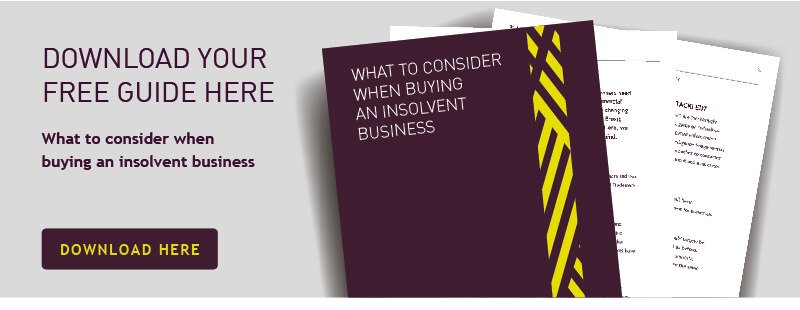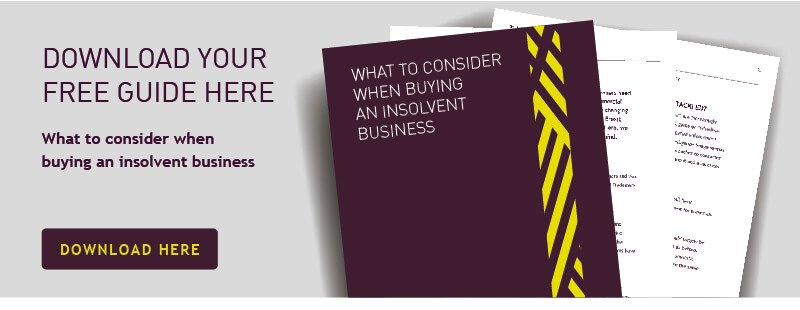It almost seems like every week we hear of another business putting its hands up after a good fight and calling in the administrators. In the happier cases, like for clothing brand Coast, a buyer will swoop in to salvage the brand - in this case Karen Millen, saving 600 jobs in the process. There are certainly great gains to be made by a “rescuer” company. You can pick up equipment, stock, a loyal customer base, supply chains, premises and years, sometimes decades, of industry knowledge and reputation for eye-wateringly low amounts. But then again, you might get very little of that!
What many people don’t realise is that once a company has been put under the control of an insolvency practitioner, the buyer’s rights to demand assurances of any kind about what’s being bought go out the window. While that practitioner will be responsible for paying the expenses of the insolvency process and, as far as a possible, the creditors - they will be discovering the ins and outs of that business at the same time as you. As such, they won’t even promise that the company owns its assets or that they’re fit for purpose. That means you have no rights of recourse against the seller should the deal fall short of expectations. If it turns out the company’s assets are owned by someone else, are broken, or are subject to third party claims (e.g. if they’re leased or subject to hire purchase) you could lose out.
The only reason anyone in their right mind would take such a gamble is for the scale of the rewards on the table – should everything come up trumps that is. Anyone considering buying an insolvent company should go in with eyes wide open. What you do in the lead up to - and during - the buying process can stack the odds greatly in your favour. If you’ve got your eye on a business that you know is struggling, here are some things to consider.
Be clear on the benefits
Before embarking on such a deal, be clear on the reasons for buying that business and ask yourself, how does this add value? How will it sit within my existing operations? How confident am I that it will perform to a profit? When Bristol-based Magmatic, the company behind ride-on suitcase brand Trunki, saved its manufacturer, the benefits of keeping its UK production afloat were clear and in-line with Trunki’s company values. Not only would the purchase allow Trunki to deliver on its promise to be innovative and dynamic – leading to the launch of its customisation programme – running its own production from Plymouth also meant the company’s responsibility to the environment and people would be better met. Forty jobs were saved in the process, 15 new jobs have since been created at the factory and Trunki’s carbon footprint was reduced a thousand times over by sidestepping a return to Chinese manufacturing. With exports soaring and sales reported at £9 million in April this year, it’s clear that the deal, which Thrings helped Magmatic reach, is among the insolvency buyout success stories.
Move fast
The nature of insolvency is that things move fast in order to reduce losses and best preserve the business. We’re talking a matter of weeks or days from offer to completion. UNILAD was acquired by its rival LADbible only 13 days after administrators were appointed, giving potential buyers mere days to formulate and submit their offers. In that time, LADbible will have needed to consider their corporate structure, the operational impact of taking on the new business, licensing, funding, VAT registration, banking and more. Ask yourself, can I meet this deadline, even if (like LADbible) you are already familiar with your target? Do I have the human resource in place to see this through?
False economies
Some have been lured by a particularly good offer before a formal insolvency process is launched, the so-called pre-pack deal. We’ve seen it with House of Fraser, which, minutes after announcing itself to be in administration, already had a £90 million deal on the table which it hoped would preserve most stores. Deals made ahead of insolvency can be accompanied by a belief that the goodwill of the business will be better preserved by reducing the level of crisis in the eyes of the world. But proceed with caution! House of Fraser is now faced with the prospect of closing 50 percent of its stores amid feuds with landlords, prompting Sports Direct’s Mike Ashley to seek a merger with Debenhams.
If the seller enters into administration after the sale, the insolvency practitioner could conclude that you paid less than market value for it and demand that you either return the assets, or pay more. While it’s often safer to buy once proceedings have been launched, should you wish to go ahead before then, obtaining a formal valuation or recording how the valuation was determined can help reduce the risk of a challenge to the bargain you have struck.
Property
From where will you trade? If you need to occupy the same premises as the seller, which isn’t unusual, does it make sense to do so in the long-term? You might be granted a license to occupy the existing premises for several months, but you will need to formalise any right of occupation (e.g. deposit or guarantee requirements), or indeed the costs and impact of any move - for example dilapidations, costs of removing and/or transporting necessary kit and the impact on employees.
Employee liabilities
In most cases, and whether you like it or not, you’ll be taking on the liabilities of the business’ employees. They’ll be employed by you as per their existing contracts and you’re likely to be responsible for any arrears of pay. If you need to change any terms or conditions of employment, or move the place of work, you’ll need to cost potential liabilities arising from this. Costs associated with redundancy or claims of unfair dismissal can be significant and you should be in a position to fund these. Evans Cycles, who like House of Fraser was bought by Sports Direct, will be making 440 employees redundant. It won’t be cheap.
So what can you do to reduce the risk? Spending time at the seller’s site, inspecting the assets, contracts and records is invaluable. Simply put, it’s the only way to ensure you know what you’re buying. While there’s a lot to consider during the quick and demanding process of buying an insolvent business, there can be great rewards - providing you do it correctly. If you buy the business, know the risks, pay the right price and plan for contingency costs.
To view the blog on Insider’s website, please click here .
For help to realise your commercial ambitions, get in touch with Melissa George or Thrings’ Restructuring and Insolvency team.


